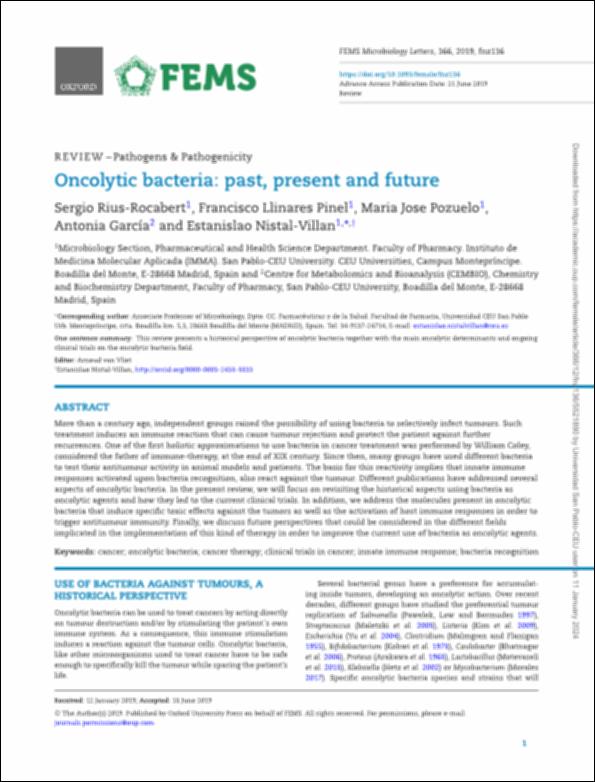Por favor, use este identificador para citar o enlazar este ítem:
http://hdl.handle.net/10637/15021Oncolytic bacteria: past, present and future
| Título : | Oncolytic bacteria: past, present and future |
| Autor : | Rius Rocabert, Sergio Llinares Pinel, Francisco Pozuelo de Felipe, María José García Fernández, Antonia Nistal Villán, Estanislao |
| Materias: | Cancer; Oncolytic bacteria; Cancer therapy; Clinical trials in cancer; Innate immune response; Bacteria recognition |
| Editorial : | Oxford University Press, Federation of European Microbiological Societies |
| Citación : | Rius-Rocabert S, Llinares Pinel F, Pozuelo MJ, García A, Nistal-Villan E. Oncolytic bacteria: past, present and future. FEMS Microbiol Lett. 2019 Jun 1;366(12):fnz136. doi: 10.1093/femsle/fnz136. PMID: 31226708 |
| Resumen : | More than a century ago, independent groups raised the possibility of using bacteria to selectively infect tumours. Such treatment induces an immune reaction that can cause tumour rejection and protect the patient against further recurrences. One of the first holistic approximations to use bacteria in cancer treatment was performed by William Coley, considered the father of immune-therapy, at the end of XIX century. Since then, many groups have used different bacteria to test their antitumour activity in animal models and patients. The basis for this reactivity implies that innate immune responses activated upon bacteria recognition, also react against the tumour. Different publications have addressed several aspects of oncolytic bacteria. In the present review, we will focus on revisiting the historical aspects using bacteria as oncolytic agents and how they led to the current clinical trials. In addition, we address the molecules present in oncolytic bacteria that induce specific toxic effects against the tumors as well as the activation of host immune responses in order to trigger antitumour immunity. Finally, we discuss future perspectives that could be considered in the different fields implicated in the implementation of this kind of therapy in order to improve the current use of bacteria as oncolytic agents. |
| URI : | http://hdl.handle.net/10637/15021 |
| Derechos: | http://creativecommons.org/licenses/by-nc-nd/4.0/deed.es |
| ISSN : | 1574-6968 |
| Fecha de publicación : | jun-2019 |
| Centro : | Universidad San Pablo-CEU |
| Aparece en las colecciones: | Facultad de Farmacia |
Los ítems de DSpace están protegidos por copyright, con todos los derechos reservados, a menos que se indique lo contrario.


